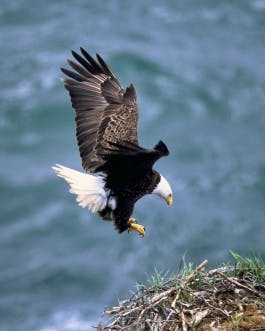 The Value of Conserving Wildlife
The Value of Conserving Wildlife
by Jamie Rappaport Clark
(This post originally appeared on Huffington Post on October 4, 2011)
Why save a lizard? Who cares about some little fly? What difference does it make if we kill off a few unwanted prairie dogs?
These are fair questions. At a time when nine percent of Americans are unemployed, another seven percent are marginally employed or working only part-time, and millions more are struggling to stay afloat, protecting obscure endangered species probably isn’t the first thing on people’s minds. But that doesn’t mean we should turn our backs on the countless species, large and small, that still need our help.
Nearly 40 years ago, our government made a commitment in the form of the Endangered Species Act to preserve all native wildlife for the benefit of future generations. And since that time the Act has been 99 percent effective in preventing the extinction of the plants and animals it protects. But tragically, Congress is preparing to use our current economic crisis as an excuse to abandon America’s commitment to preventing extinction.
 Before the August recess, no fewer than 13 different proposals had been introduced to limit the federal government’s ability to protect endangered species (see Assault on Wildlife: The Endangered Species Act Under Attack). Since Congress returned from recess, another four have been added to the list, and more will no doubt surface long before a comprehensive funding bill is finally passed this fall.
Before the August recess, no fewer than 13 different proposals had been introduced to limit the federal government’s ability to protect endangered species (see Assault on Wildlife: The Endangered Species Act Under Attack). Since Congress returned from recess, another four have been added to the list, and more will no doubt surface long before a comprehensive funding bill is finally passed this fall.
At the center of nearly all of these attacks on our landmark wildlife conservation law is the implicit argument that saving imperiled plants and animals is simply a luxury we can no longer afford. Some members of Congress are taking it a step further, exploiting our country’s very real financial difficulties by pinning job losses on endangered species protections. Of course, this sham calculus disguises the fact that many of these politicians rely on certain big corporate interests hostile to the Endangered Species Act to line their campaign coffers.
Despite the protestations of anti-wildlife politicians, there are very good reasons to protect a lizard, or a fly or a prairie dog. Though they may seem trivial, these animals are an integral part of the web of life that sustains us all. Lizards control insect pests and provide food for hawks. Flies feed reptiles and can help pollinate crops. Prairie dogs mow down prairie grasses, reducing risk of wildfire, and they provide food for ferrets, badgers and owls. What’s more, by fighting to save these species, we are preserving the vitality of the entire ecosystems that they inhabit.
There are also practical reasons for saving as many imperiled species as we can. The ESA acknowledges the direct link between maintaining biodiversity and our own well-being. For example, one economist has estimated that America’s plants and animals provide us with “ecosystem services” (such as erosion control, flood protection, air and water filtration, sedimentation, carbon sequestration, providing nutrients, crop pollination, etc.) totaling $33 trillion per year. Plants like the Pacific yew tree, Madagascar periwinkle and mamala tree have all led to promising treatments for diseases like cancer, leukemia and AIDS. And expenditures for wildlife-related recreation accounted for more than $122 billion in 2006 — about one percent of our GDP.
What doesn’t show up on the ledger though is the value of upholding the principles of good stewardship. The great conservationist Aldo Leopold once wrote, “The last word in ignorance is the man who says of an animal or plant, ‘What good is it?’ If the land mechanism as a whole is good, then every part is good, whether we understand it or not.”
We should ask ourselves instead, what will be left when all the lizards, and flies and prairie dogs are gone? What will happen to our lakes and forests, our deserts and oceans, our rivers and prairies, when fewer and fewer living creatures call them home? If we allow piecemeal changes now to our most important environmental laws, what else might politicians find inconvenient to protect?
The attacks on America’s great conservation legacy may seem small and insignificant. But each one tugs at a thread that could unravel the entire fabric of the great safety net we have built over four decades. Killing off a few lizards or flies or prairie dogs isn’t going to rescue our flailing economy. But it could very well ruin us all.








Follow Defenders of Wildlife
facebook twitter instagram youtube tiktok threads